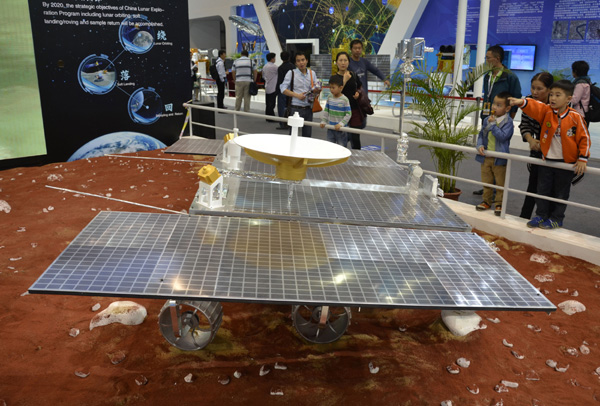 |
|
A full-scale model of a Chinese-made Mars rover is displayed at the 10th China International Aviation and Aerospace Exhibition in Zhuhai, Guangdong province, on Friday. [LIU HUAIYU/CHINA DAILY] |
BEIJING - China hopes to put a rover on Mars around 2020, complete a manned space station around 2022 and test a heavy carrier rocket around 2030, a top space scientist revealed Sunday.
Lei Fanpei, chairman of the China Aerospace Science and Technology Corporation (CASC), the main contractor for the space program, revealed the details in an interview with Xinhua after the launch of CBERS-4, a satellite jointly developed with Brazil, from the Taiyuan base, by a Long March-4B rocket.
It was the 200th flight of the Long March variants since April 1970 when a Long March-1 carried China's first satellite, Dongfanghong-1, into space.
MARS PROBE 2020
A feasibility study on the country's first Mars mission is completed and the goal is now to send an orbiter and rover to Mars.
There has been no official announcement about a Mars probe yet, but Lei expects a Long March-5 carrier, still at the development stage, to take the orbiter into a Martian orbit around 2020 from a new launch site on south China's island province of Hainan.
China's space scientists have had their eyes on the Red Planet as their next destination since the successful soft landing on the moon late last year.
Last month, an actual-size model of a possible Mars rover was on display at Airshow China 2014, the first glimpse of how the vehicle might turn out.
China made an unsuccessful attempt to reach Mars in 2011 aboard a Russian rocket, but failed to complete the mission because of an accident during orbital transfer.
SPACE STATION 2022
China's manned space station program is progressing steadily. Various modules, vehicles and ground facilities are nearing readiness.
Development and manufacture of major space products are at key stages, including the second space lab Tiangong-2, the Tianzhou-1 cargo ship, Long March-7 rockets and Shenzhou-11 spacecraft. The core module and two space labs will be tested soon, Lei said.
A new launch center in Hainan, the fourth after Taiyuan, Jiuquan and Xichang, is almost complete and can already launch some spacecraft.
The Tiangong-2 space lab will be launched around 2016 along with the Shenzhou-11 spacecraft and Tianzhou-1 cargo ship. Around 2018, a core experimental module for the station will be put in place.
By around 2022, China's first orbiting space station should be completed. It will consist of three parts -- a core module attached to two labs, each weighing about 20 tonnes.
Tiangong-1 was launched in September 2011. In June 2012, the Shenzhou-9 executed the first manual space docking with Tiangong-1, another essential step in building a space station.
HEAVY ROCKET
A powerful carrier rocket is essential for a manned moon landing.
"We hope to make breakthroughs within four or five years on design and key technology for the heavy carrier, a solid foundation for developing such a rocket," he said.
Breakthroughs are needed on the overall design of the rocket, including development of a 460 tonne thrust liquid oxygen and kerosene engine and a 220 tonne liquid hydrogen engine.
"We hope to finish all these within the next 15 years, so the heavy rocket will make its first maiden flight sometime around 2030," Lei said
The rocket is envisaged as having a payload capacity of 130 tonnes to low Earth orbit. Once in service, it will help with missions between 2030 and 2050, and secure China's position in terms of space exploration and technology.
